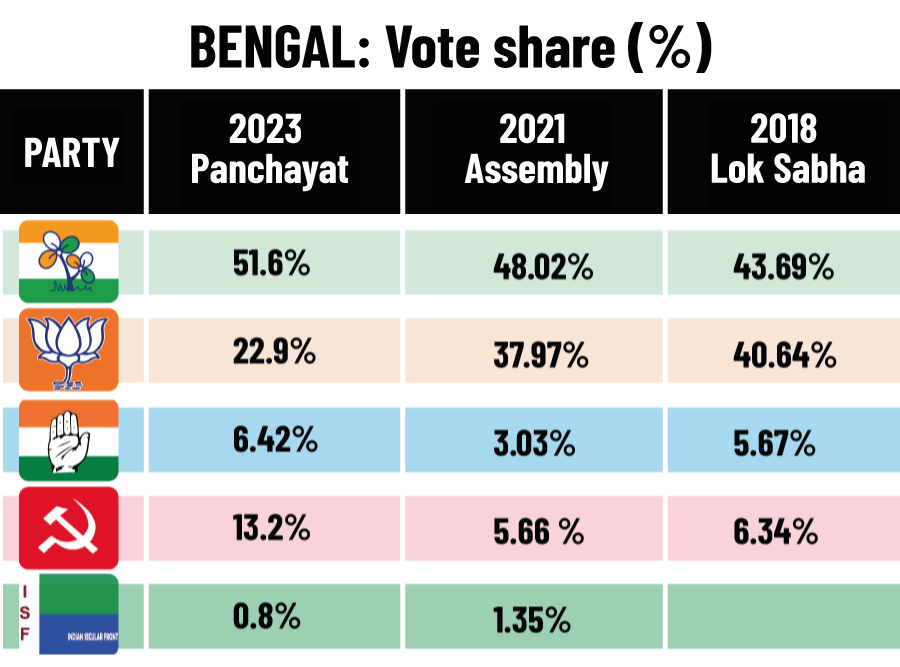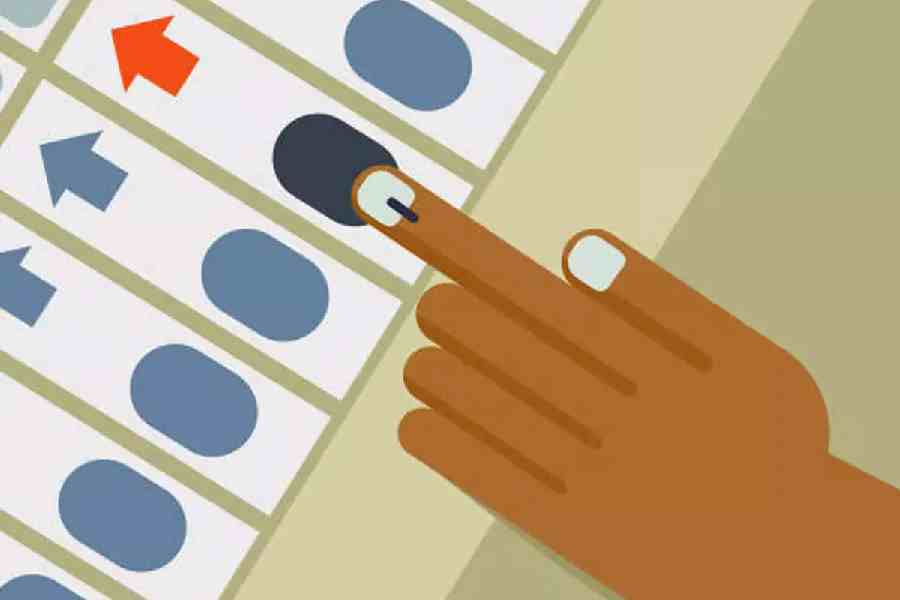Sample the following Zilla Parishad results from the recently-concluded rural polls in Bengal:
i) ZP seat 8 in the Hindu-dominated area of Gazole in Malda: Trinamul Congress candidate Rita Singha defeated her nearest BJP rival Shampa Sarkar Barman by a margin of 1,785 votes. CPI-M candidate Sanati Murmu came third with 6,876 votes. Last census record states that nearly 75 per cent of the population of the Gazole block are Hindus and over 96 per cent lives in rural areas.
ii) ZP seat 3 in Kumargram, Alipurduar: Trinamul Congress candidate Golap Roy defeated her nearest BJP rival Amita Mahato by a margin of 408 votes. CPI-M’s Malabika Maulik finished third with 4,983 votes. The area falls under the Kumargram Assembly constituency and BJP’s Manoj Oraon is its sitting MLA. The local Alipurduar MP is BJP’s John Barla.
iii) ZP seat 21 in Jhalda-II, Purulia: Congress and CPI-M candidates feature at second and third positions respectively behind Trinamul’s Bijay Kumar, the winner of the seat. The BJP candidate finds himself in a distant fourth position securing less than half the number of votes received by the Congress and getting a sizable number of votes less than the Left candidate as well. Ironically, Jhalda-II falls under the Joypur assembly constituency where BJP’s Narahari Mahato secured a massive 32 per cent jump in the number of votes compared to the previous state elections to snatch the seat away from Trinamul in 2021. BJP’s Jyotirmay Singh Mahato is the MP from Purulia under which Joypur and Jhalda fall.
iv) ZP seat 1 in Bagdah, North 24 Parganas: BJP’s Dipali Biswas finds herself 1,681 votes short of Trinamul’s Sampa Adhikary who romped home in the seat that’s among the constituents of the Hindu refugee Matua heartland of south Bengal. Left constituent Forward Bloc candidate Priyanka Biswas, interestingly, pulled 5830 votes in her kitty.
v) ZP seat 51 in Deshapran block, East Midnapore: BJP’s Keshab Nandi loses to Trinamul’s Sandip Kumar Bera by a margin of just 75 votes in a seat which falls under the Contai subdivision that is Bengal Leader of Opposition Suvendu Adhikari’s hometown and perceived to be a BJP fortress. The CPI-M candidate bags 1,564 votes.

TTO Graphics
The above examples are from diverse corners of Bengal, especially from areas where the BJP made strong inroads in the 2019 Lok Sabha polls and held its ground in the 2021 state elections, despite Trinamul Congress’s landslide victory that year. And the trend quite clearly shows that the anti-Trinamul Congress votes, which had coagulated under the saffron banner in 2019 and 2021, have now split between the BJP and the Left in the Hindu-dominated areas of the state and has cost the Lotus brigade a significant number of Zilla Parishad seats.
Although the examples are, by no means, exhaustive, the voting pattern can be quite easily identified in significant tracts of demographic spaces in the state and especially within the highest tier of the panchayati system which is most congruent with Assembly and Lok Sabha constituencies.
The pattern is also consistent with the overall vote share of the parties in the recently concluded panchayat polls, if one chooses to ignore allegations of large-sc ale malpractices in polling and counting centres for the time being and take those numbers at face value.
The final vote share figures show that while Trinamul has grabbed the lion’s share of votes at 51.6 per cent, the BJP is down to 22.9 per cent. That’s 17.74 per cent less than what the BJP amassed in the 2019 general elections and 15.07 per cent less than what it received in 2021 state polls.
Conversely, the Left’s 13.2 per cent vote share in the rural polls is a jump of 6.86 per cent compared to 2019 and a 7.54 per cent spike compared to the Assembly elections two years ago.
If, for argument’s sake, one deducts 10 per cent from Trinamul Congress’s vote share to accommodate the allegations of poll fraud even then it becomes evident that the party has managed to hang on to its vote share close to the previous Lok Sabha polls.
The same, however, isn’t true for the BJP. Figures confirm that the party’s meteoric jump from two to 18 Lok Sabha seats in 2019, which allowed it to burst into the state’s political space and firmly establish itself as the principal Opposition party, was on account of its 22.25 percent rise in vote share compared to the general elections of 2014. The principal constituent of those numbers came from the CPI-M which registered a 16.72 per cent dip, given that the Trinamul latched onto 22 seats, 12 less compared to its earlier performance, despite enhancing its vote share by 4.64 per cent.
Considering the takeaways from the panchayat polls, what could be worrying for the saffron brigade is the trend that a chunk of voters, whose trust the BJP had earned four years ago, are showing clear signs of drifting back to their traditional following ahead of next year's Lok Sabha elections.
BJP spokesperson Samik Bhattacharya differs. “There can be no political analysis from the panchayat poll results given that it was reduced to a complete farce by the ruling dispensation. We don’t accept the figures that the polls have officially thrown up because of the widespread intimidation and fraud which took place. The results are many times removed from the true political aspirations of the people of this state,” he claimed.
“The political scenario in the state will change very fast and expect that to happen in just a couple of months. The BJP’s count of Lok Sabha seats from Bengal will begin from 24 seats as base,” Bhattacharya asserted.
CPI-M leader Sujan Chakraborty’s agreement with his BJP counterpart ended at the allegation of the poll figures being a poor reflection of the people’s true mandate and in his questioning the legitimacy of the commission’s figures.
“Based on the results of the 2018 panchayat, 2019 Lok Sabha and the 2021 state polls, a perception was built that BJP is a rising force in Bengal. This election has proved that the Left and its allies are a rising force and the BJP is actually a receding force,” he maintained.
Chakraborty argued that not just the BJP, but the Trinamul’s vote share has also dipped by a significant percentage compared to the 2021 figures “despite the vote loot and counting dacoity” vis-a-vis the parallel rise in vote share of the Left-Congress-ISF block and that the ongoing trend, if maintained, could upset many equations for the upcoming general elections.











